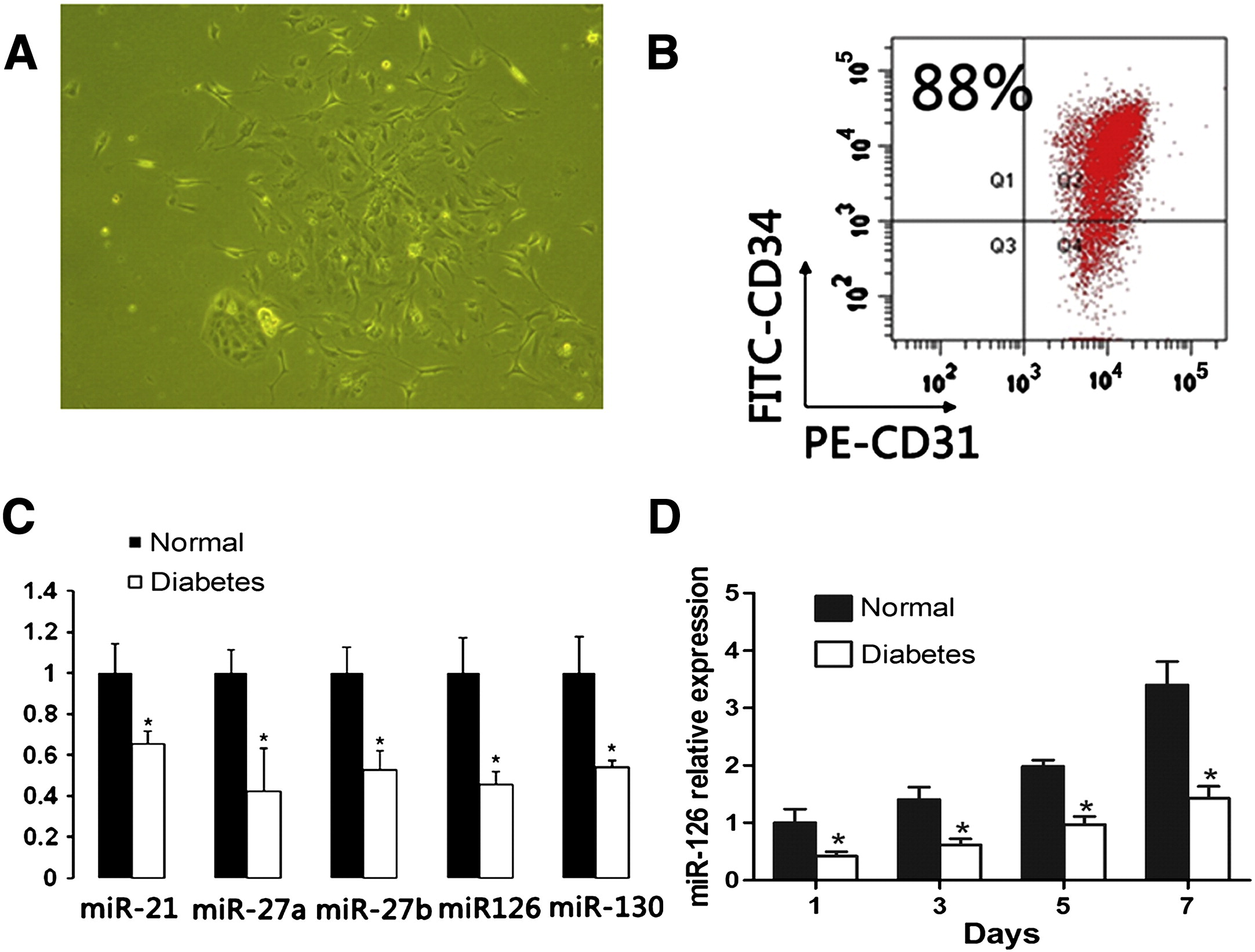Diabetes mellitus (DM) adversely affects the number and function of circulating endothelial progenitor cells (EPCs). Consequently, there is also a reduction in the repair mechanism of these cells, which is a critical and initiating factor in the development of diabetic vascular disease. Researchers from the Jiaotong University School of Medicine utilized LC Sciences’ services to analyze miR expression profiles in EPCs from patients with DM and choose the most significantly regulated miR to study its possible role on EPC dysfunction and elucidate its mechanism of action. EPCs were collected from subjects with Type II DM and non-diabetic control subjects. Total RNA was harvested from EPCs, and a total of 5 candidate miRNAs were identified by microarray screening and were quantified by TaqMan real-time PCR. Lentiviral vectors expressing miR-126 and miR-126 inhibitor (anti-miR-126) were transfected into EPCs, and the EPC colony-forming capacity, proliferation activity, migratory activity, differentiation capacity, and apoptotic susceptibility were determined and Western Blotting and mRNA real-time PCR analyses were performed. To study the mechanisms, lentiviral vectors expressing Spred-1 and a short interfering RNA (siRNA) targeting Spred-1 were prepared. Five miRs were aberrantly downregulated in EPCs from DM patients. These miRs included miR-126, miR-21, miR-27a, miR-27b and miR-130a. Anti-miR-126 inhibited EPC proliferation, migration, and enhanced apoptosis. Restored miR-126 expression in EPCs from DM promoted EPC proliferation, migration, and inhibited EPC apoptosis ability. Despite this, miR-126 had no effect on EPC differentiation. miR-126 overexpression significantly downregulated Spred-1 in EPCs. The knockdown of Spred-1 expression in EPCs from DM promoted proliferation, migration, and inhibited apoptosis of the cells. The signal pathway of miR-126 effecting on EPCs is partially mediated through Ras/ERK/VEGF and PI3K/Akt/eNOS regulation. This study provides the first evidence that miR-126 is downregulated in EPCs from diabetic patients, and impairs EPCs-mediated function via its target, Spred-1, and through Ras/ERK/VEGF and PI3K/Akt/eNOS signal pathway.

A) Early EPC isolation from PMBCs. B) FACS analysis showed that 88% cells were both positive for CD31 and CD34. C) Differentially expressed miRNAs in diabetic endothelial progenitor cells. The five most notable aberrantly expressed miRNAs were also identified by TaqMan real-time PCR. D) The EPCs were cultured for a week, miR-126 expression were measured in days 1, 3, 5, and 7. Data are expressed as mean ± SD (n = 3), *P < 0.05 compared with normal group.
Related Service
miRNA Microarray Service – LC Sciences provides a miRNA expression profiling service using microarrays based on our in-house developed µParaflo® technology platform. We have standard arrays for all mature miRNAs of all species available in the latest version of the miRBase database (Release 21, July 2014). Our service is comprehensive and includes sample labeling, array hybridization, image data processing and in-depth data analysis. Two-three weeks after receiving your total RNA samples, we’ll send you both the raw and fully analyzed data. [Learn more…]
Reference
Meng S, Cao JT, Zhang B, Zhou Q, Shen CX, Wang CQ. (2012) Down regulation of microRNA-126 in endothelial progenitor cells from diabetes patients, impairs their functional properties, via target gene Spred-1. Journal of Molecular and Cellular Cardiology 53(1), 64-72. [abstract]
